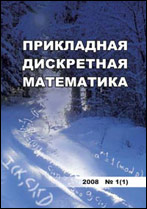|
Applied Graph Theory
Discrete closed one-particle chain of contours
P. A. Myshkis, A. G. Tatashev, M. V. Yashina
Moscow Automobile and Road Construction State Technical University (MADI),
Moscow, Russia
Abstract:
A discrete dynamical system called a closed chain of contours is considered. This system belongs to the class of the contour networks introduced by A. P. Buslaev. The closed chain contains $N$ contours. There are $2m$ cells and a particle at each contour. There are two points on any contour called a node such that each of these points is common for this contour and one of two adjacent contours located on the left and right. The nodes divide each contour into equal parts. At any time $t=0,1,2,\dots$ any particle moves onto a cell forward in the prescribed direction. If two particles simultaneously try to cross the same node, then only the particle of the left contour moves. The time function is introduced, that is equal to $0$ or $1$. This function is called the potential delay of the particle. For $t\ge m$, the equality of this function to $1$ implies that the time before the delay of the particle is not greater than $m$. The sum of all particles potential delays is called the potential of delays. From a certain moment, the states of the system are periodically repeated (limit cycles). Suppose the number of transitions of a particle on the limit cycle is equal to $S(T)$ and the period is equal to $T$. The ratio $S(T)$ to $T$ is called the average velocity of the particle. The following theorem have been proved. 1) The delay potential is a non-increasing function of time, and the delay potential does not change in any limit cycle, and the value of the delay potential is equal to a non-negative integer and does not exceed $ 2N/3$. 2) If the average velocity of particles is less than 1 for a limit cycle, then the period of the cycle (this period may not be minimal) is equal to $(m+1)N$. 3) The average velocity of particles is equal to $v=1-{H}/({(m+1)N})$, where $H$ is the potential of delays on the limit cycle. 4) For any $m$, there exists a value $N$ such that there exists a limit cycle with $H>0$ and, therefore, $v<1$.
Keywords:
dynamical system, contour network, limit cycle, potential of delays.
Citation:
P. A. Myshkis, A. G. Tatashev, M. V. Yashina, “Discrete closed one-particle chain of contours”, Prikl. Diskr. Mat., 2021, no. 52, 114–125
Linking options:
https://www.mathnet.ru/eng/pdm742 https://www.mathnet.ru/eng/pdm/y2021/i2/p114
|

| Statistics & downloads: |
| Abstract page: | 120 | | Full-text PDF : | 41 | | References: | 21 |
|




 Contact us:
Contact us: Terms of Use
Terms of Use
 Registration to the website
Registration to the website Logotypes
Logotypes







 Citation in format
Citation in format 